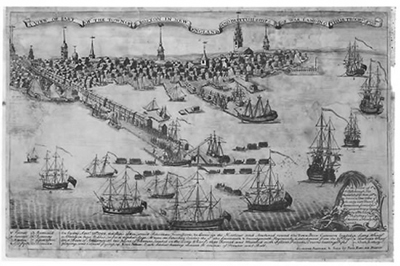
|
View Larger Image |
Paul Revere engraving, 1770 The 1760s witnessed tremendous unrest in Boston, as many colonists responded with protests to each new piece of British legislation. The Stamp Act of 1765 prompted widespread outrage, triggering property destruction, boycotts of imported British goods, and the Stamp Act Congress, a meeting with representatives from throughout the colonies. When the Townshend Acts of 1767 led to renewed boycotts and unrest, the British government sent troops to Boston. This engraving, published in 1770, commemorates the troops’ arrival on September 30, 1768, and their landing the following day. Over 700 men landed and marched through the town, with fixed bayonets, a train of artillery, and the musical and martial accompaniment of fifes and drums. The British chose to station the troops in the town itself, rather than in the empty fort on Castle Island in the Boston harbor. Housing proved a significant problem. Many troops camped on the Boston Commons. Others found shelter in buildings which James Murray, Elizabeth’s brother, decided to rent to British authorities; these structures included the sugar manufacturing building of James Smith, Elizabeth’s second husband. For more on the repercussions of the troops’ arrival and quartering in Murray property, see Patricia Cleary, Elizabeth Murray: A Woman’s Pursuit of Independence in Eighteenth-Century America (Amherst: University of Massachusetts Press, 2000), 101-104. |
||
Paul Revere engraving of the Boston Massacre |
|||
 “A View of Part of the Town of Boston in New England and British Ships of War Landing Their Troops, 1768,” engraving by Paul Revere, 1770. Courtesy, American Antiquarian Society
“A View of Part of the Town of Boston in New England and British Ships of War Landing Their Troops, 1768,” engraving by Paul Revere, 1770. Courtesy, American Antiquarian Society

